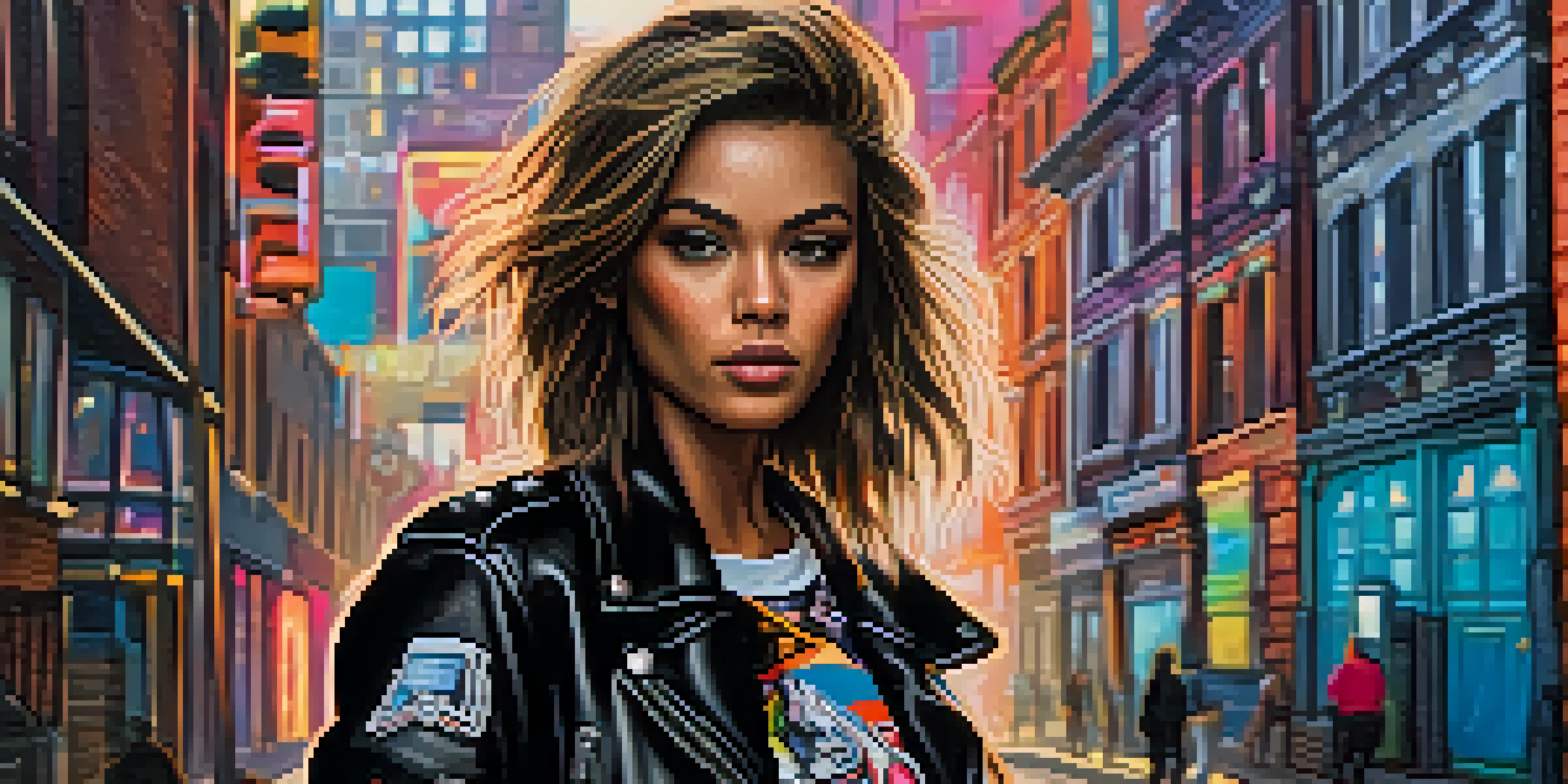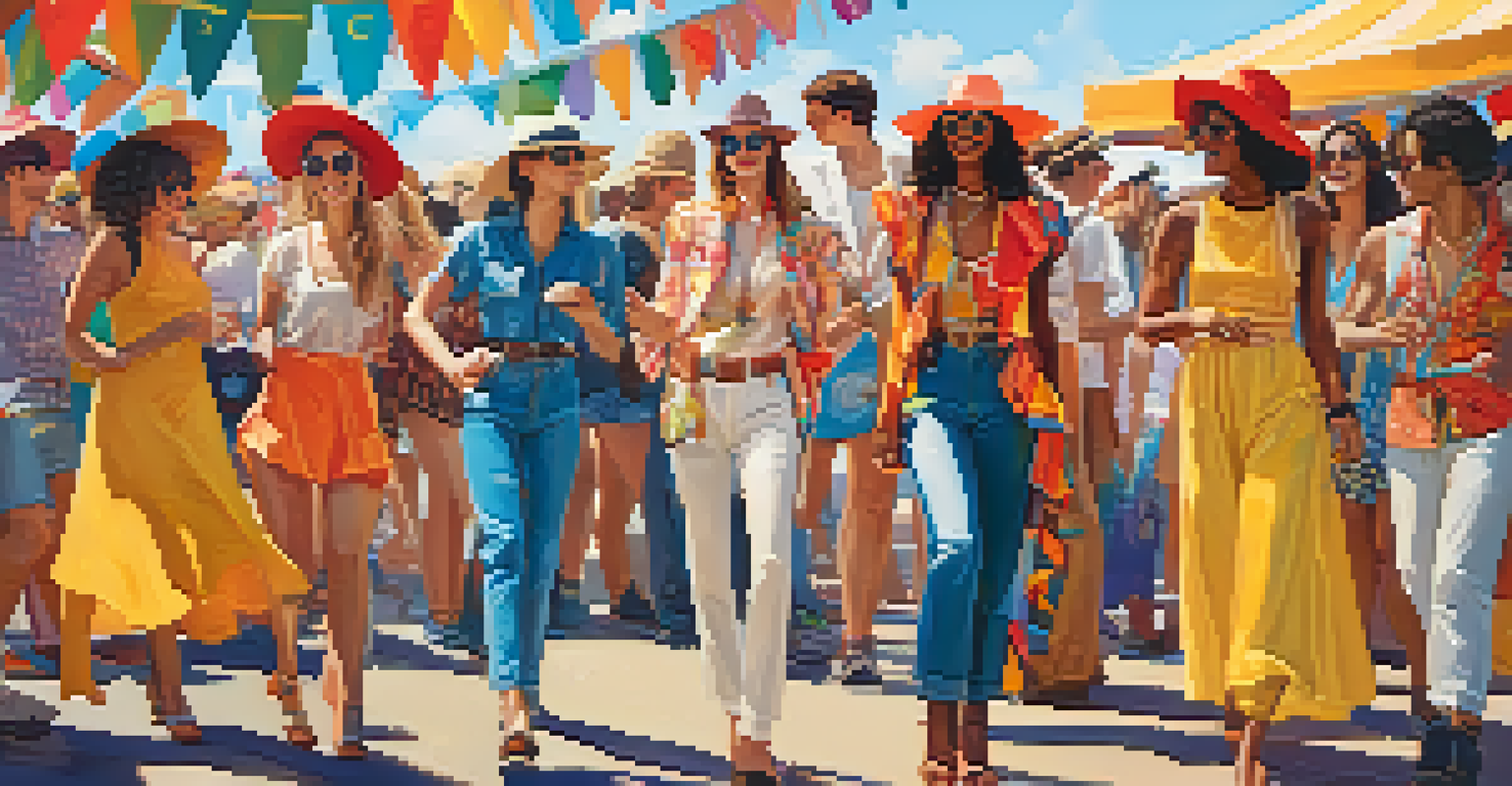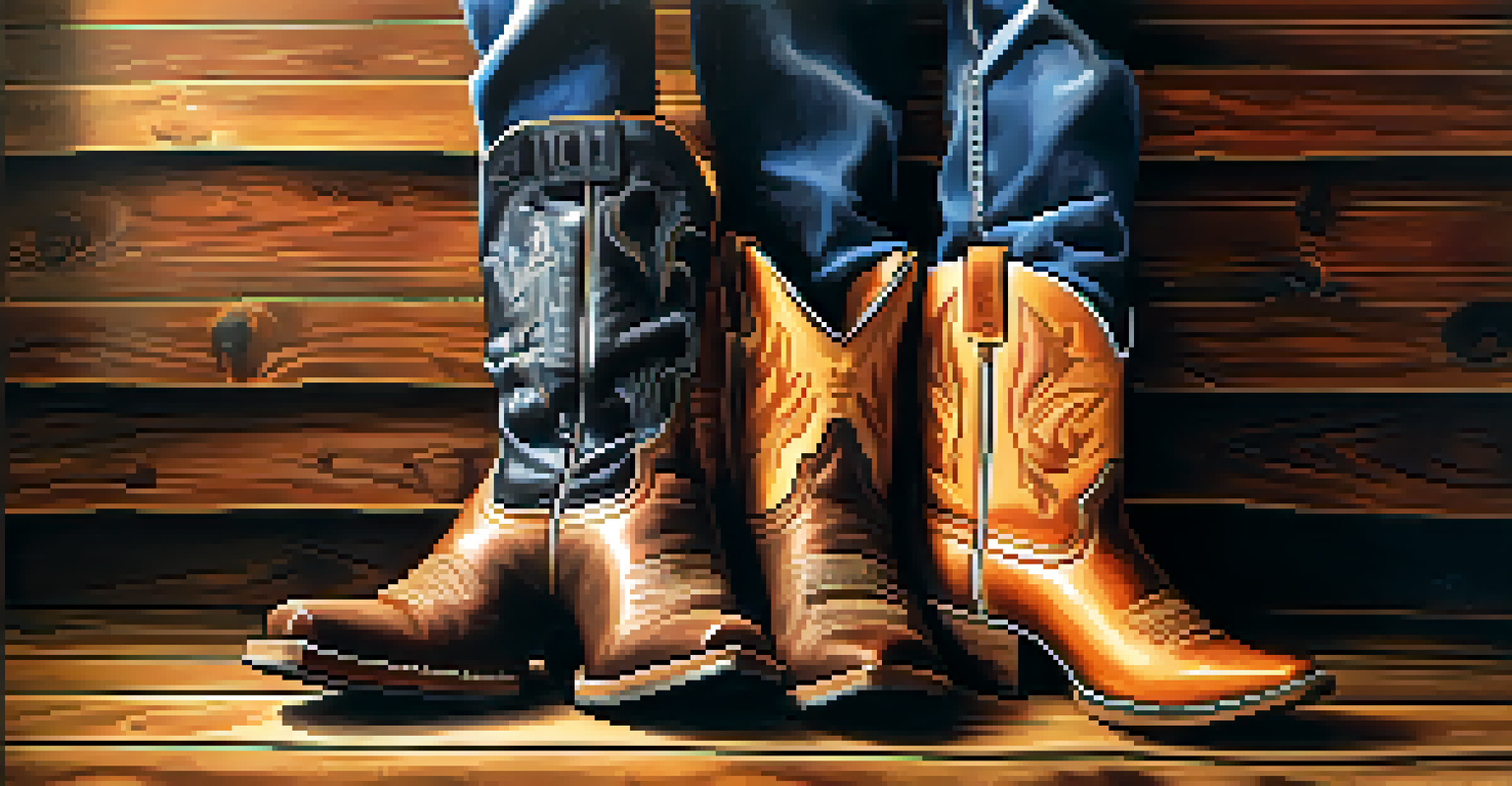The Influence of Music Genres on Fashion Trends Worldwide

Rock 'n' Roll: The Birth of Rebel Fashion
The rock 'n' roll era of the 1950s was a pivotal moment for fashion, as it embraced a rebellious spirit characterized by leather jackets, denim, and bold hairstyles. Icons like Elvis Presley and later, The Rolling Stones, not only influenced music but also shaped the way youth expressed their individuality through style. This trend of rock-inspired fashion became a symbol of defiance against conventional norms, sparking a cultural revolution.
Fashion is the armor to survive the reality of everyday life.
As the decades progressed, punk rock emerged in the late 1970s, further pushing the boundaries of fashion. With spiked hair, band t-shirts, and DIY aesthetics, punk became synonymous with anti-establishment sentiments. This genre not only influenced the music scene but also left a lasting mark on fashion, encouraging a raw, unfiltered approach to style that still resonates today.
Even in contemporary fashion, the influence of rock 'n' roll is evident, with designers often drawing inspiration from vintage rock aesthetics. Whether it's the resurgence of leather jackets or the popularity of graphic tees, the rebel spirit of rock continues to thrive in modern wardrobes, proving that music and fashion are forever intertwined.
Hip-Hop: A Catalyst for Urban Fashion Trends
Emerging from the streets of the Bronx in the 1970s, hip-hop has played a significant role in shaping urban fashion trends. Baggy jeans, oversized t-shirts, and flashy sneakers became staples of the hip-hop wardrobe, reflecting a cultural movement that prioritized comfort and individuality. Artists like Run-DMC and later, Jay-Z, showcased how fashion could be both a personal statement and a form of cultural expression.

As hip-hop evolved, so did its fashion influence, leading to high-fashion collaborations and the rise of streetwear. Brands like Supreme and Off-White gained traction, merging luxury with everyday style and attracting a global audience. This unexpected crossover has blurred the lines between high fashion and street style, making hip-hop a driving force in the fashion industry.
Music Shapes Fashion Identity
Various music genres like rock, hip-hop, and pop have profoundly influenced fashion trends, allowing individuals to express their unique identities through style.
Today, hip-hop continues to shape trends, with artists using their platforms to influence everything from footwear to luxury brands. The genre’s ability to reflect societal changes and challenges has made it a powerful player in the fashion world, proving that style is not just about aesthetics but also about identity and culture.
Pop Music: Colorful Trends and Mainstream Appeal
Pop music, with its catchy tunes and widespread appeal, has a unique way of dictating fashion trends across the globe. Artists like Madonna and Britney Spears set the stage for bold fashion statements, from lace gloves to low-rise jeans, capturing the essence of their eras. These trends often go beyond the music itself, influencing mass-market fashion and inspiring fans to emulate their favorite stars.
Music can change the world because it can change people.
The 2000s saw a surge in ‘celebrity culture,’ where pop stars became fashion icons, further solidifying the connection between music and style. With social media amplifying this influence, fans can instantly see and replicate their favorite looks, creating a cycle of inspiration and imitation. This has led to a more democratized approach to fashion, where trends can rise and fall rapidly.
Today’s pop stars like Billie Eilish and Harry Styles continue to push boundaries with their eclectic styles, challenging traditional gender norms and embracing individuality. As they experiment with fashion, they encourage fans to do the same, reinforcing the idea that music and fashion are not just industries but also forms of self-expression.
Country Music: Traditional Styles with Modern Twists
Country music, often associated with rustic charm and Southern culture, has its own distinct fashion narrative. Classic elements like cowboy boots, denim, and plaid shirts reflect the genre's roots, while artists like Dolly Parton and Garth Brooks have introduced modern flair to traditional styles. This blend of old and new allows country fashion to evolve while staying true to its heritage.
In recent years, country music has seen a resurgence in popularity, bringing with it a renewed interest in Western-inspired fashion. Events like the Country Music Awards showcase this trend, as artists don elaborate outfits that mix traditional Western wear with contemporary aesthetics. This has opened the door for fashion brands to capitalize on the country vibe, creating a unique niche in the fashion market.
Cultural Expression Through Clothing
Fashion trends in genres such as reggae and country reflect cultural pride and heritage, showcasing how music and style can celebrate community values.
Furthermore, country music's influence extends beyond the genre itself, impacting mainstream fashion as well. Collaborations between country artists and fashion designers highlight this crossover, as styles inspired by the genre find their way into everyday wardrobes, proving that country fashion is both timeless and adaptable.
Electronic Dance Music: Neon Lights and Urban Edge
The rise of electronic dance music (EDM) has brought vibrant and innovative fashion trends to the forefront. Festivals like Coachella and Tomorrowland have become platforms for self-expression, with attendees donning bold colors, unique patterns, and eye-catching accessories. This festival culture encourages fans to experiment with their looks, often incorporating elements of streetwear and high fashion.
EDM artists like Marshmello and Deadmau5 have also influenced fashion through their distinct branding and signature styles, often featuring playful graphics and futuristic designs. This has led to a new wave of fashion that embraces a playful, avant-garde aesthetic, appealing to a younger demographic eager to stand out. The focus on individuality aligns perfectly with the EDM ethos of freedom and creativity.
As the EDM scene continues to grow, so does its impact on fashion trends. The genre’s emphasis on community and self-expression creates a space where fashion can be a form of art, inspiring fans to not only enjoy the music but also to make bold fashion choices that reflect their personalities.
Reggae: Roots, Culture, and Natural Vibes
Reggae music, with its origins in Jamaica, has profoundly influenced fashion, promoting a style that emphasizes comfort and cultural pride. The iconic Bob Marley popularized the Rastafarian color palette, which includes green, yellow, and red, and showcased how music can reflect cultural identity. This laid the groundwork for reggae-inspired fashion, which often incorporates loose-fitting clothing and earth tones.
The laid-back vibe of reggae music also translates into fashion choices, where natural fabrics and casual silhouettes reign supreme. Accessories like beaded necklaces and colorful head wraps are commonly associated with this genre, promoting a sense of community and connection to roots. This approach to fashion encourages individuals to embrace their heritage while expressing their personal style.
Rebellion and Individuality in Style
Genres like punk and metal emphasize rebellious aesthetics, encouraging fans to embrace fierce individuality and challenge societal norms through their fashion choices.
Today, reggae continues to inspire fashion trends, particularly in the realm of streetwear. The genre's influence can be seen in various collections that embrace a vibrant aesthetic, celebrating both the music and the culture it represents. As reggae maintains its global appeal, its fashion impact remains a testament to the enduring connection between music and style.
Metal: Dark Aesthetics and Fierce Individuality
Metal music, known for its powerful sound and intense energy, has a distinct fashion identity that emphasizes individuality and rebellion. Leather jackets, band t-shirts, and dark colors are staples of metal fashion, reflecting the genre's raw intensity. Bands like Metallica and Iron Maiden not only shaped the sound of music but also defined a style that resonates with fans worldwide.
The aesthetics of metal fashion often challenge societal norms, allowing fans to express their identity boldly. Heavy metal festivals, such as Download and Wacken, showcase this unique style, where attendees proudly sport their favorite band merch and edgy accessories. This sense of community fosters a shared identity among metal enthusiasts, bridging the gap between music and fashion.

Even as metal evolves, its influence on fashion remains significant. Contemporary designers often draw inspiration from the genre, incorporating elements like spikes, chains, and dark palettes into their collections. This enduring connection highlights how music can transcend auditory experiences, leaving an indelible mark on the world of fashion.